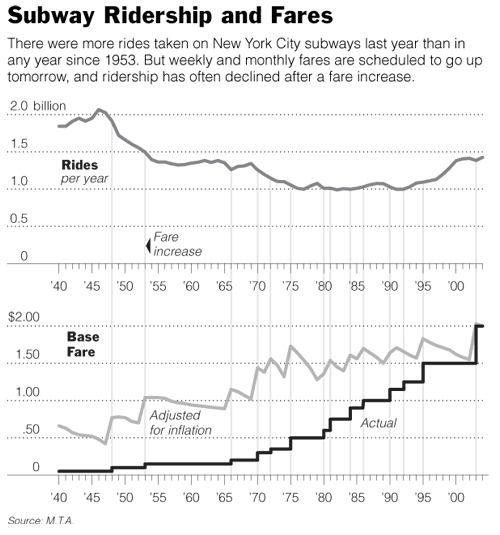This is a little late, but I’ve been meaning to blog about the recent MTA fare hike. Actually, unlike previous fare hikes, they didn’t raise the base fare, which is still $2. Instead, they reduced the discount for purchasing unlimited-ride MetroCards.
The cost of a 7-day card will rise to $24 from $21; a 30-day card to $76 from $70; and a 7-day express bus card to $41 from $37. The price of a one-way express bus ride will increase to $5 from $4.
This is only the fifteenth fare increase in the subway’s 100 year history, but it is the second in two years. It seems the last one didn’t go so well. When they raised the fares in 2003, what happened was that bargain-savvy New Yorkers simply switched to buying reduced-rate unlimited-ride cards. Because the whole system is now computerized and doesn’t require retooling every single turnstile, it is now much less costly for them to raise or adjust the fares — we can expect such adjustments to happen on a much more frequent basis.
But we shouldn’t take these fare increases lying down. First of all, as some may remember, when the 2003 fare increase was announced it was justified because of a $236 million deficit; however, it turned out that the MTA was keeping double books, and “it could have shown a $83 million surplus for [that] year.” I’m still not sure why the fare increase was finally allowed to stand, but it seems strange that nobody is raising a ruckus when the MTA claims that it
needs to come up with $600 million to balance the books, with annual deficits rising to $1 billion in 2008, according to current projections.
Right, and I have a bridge in Brooklyn I’d like to sell you!
On a side note, I was surprised by two things in the following graphic: First, that ridership declines after each fare increase. This may not be surprising to some — but it always seemed to me that if people are taking the subway or the bus somewhere they don’t really have much of a choice. Do people just stay home? And secondly, it shocked me to see that ridership is only now catching up with its peak in the 1950s. I would have assumed it had been steadily growing ever since then — but I suppose it was just after the war that people started buying cars, so that must explain much of the initial drop; but then it continued to decline, or remain low, even during the oil crisis in the 70s…

